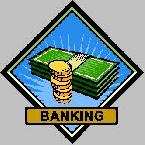
 |
|
| Financial Terms | |
| Underground Economy |
|
Information about financial, finance, business, accounting, payroll, inventory, investment, money, inventory control, stock trading, financial advisor, tax advisor, credit.
Main Page: financial, stock trading, financial advisor, finance, credit, accounting, inventory control, business, |
Definition of Underground Economy
Underground EconomyEconomic activity not observed by tax collectors and government statisticians.
Related Terms:global economyan economy characterized by the international Closed EconomyAn economy in which imports and exports are very small relative to GDP and so are ignored in macroeconomic analysis. Contrast with open economy. Open EconomyAn economy which engages in a significant amount of trade. Contrast with closed economy. Closed-end fundAn investment company that sells shares like any other corporation and usually does not Closed-end mortgageMortgage against which no additional debt may be issued. Global bondsBonds that are designed so as to qualify for immediate trading in any domestic capital market Global fundA mutual fund that can invest anywhere in the world, including the U.S.  GlobalizationTendency toward a worldwide investment environment, and the integration of national capital globalizationa changeover in market focus from competition economic components modelAbrams’ model for calculating DLOM based on the interaction of discounts from four Economic components. NPV (net present value of cash flows)Same as PV, but usually includes a subtraction for an initial cash outlay. PV (present value of cash flows)the value in today’s dollars of cash flows that occur in different time periods. Absolute priorityRule in bankruptcy proceedings whereby senior creditors are required to be paid in full Accelerated cost recovery system (ACRS)Schedule of depreciation rates allowed for tax purposes. Accounting insolvencyTotal liabilities exceed total assets. A firm with a negative net worth is insolvent on After-tax profit marginThe ratio of net income to net sales.  After-tax real rate of returnMoney after-tax rate of return minus the inflation rate. Asset activity ratiosRatios that measure how effectively the firm is managing its assets. Asymmetric informationinformation that is known to some people but not to other people. Asymmetric taxesA situation wherein participants in a transaction have different net tax rates. Average cost of capitalA firm's required payout to the bondholders and to the stockholders expressed as a Average tax ratetaxes as a fraction of income; total taxes divided by total taxable income. Balance of tradeNet flow of goods (exports minus imports) between countries. Bank for International Settlements (BIS)An international bank headquartered in Basel, Switzerland, which BARRA's performance analysis (PERFAN)A method developed by BARRA, a consulting firm in Basket tradesRelated: Program trades. Before-tax profit marginThe ratio of net income before taxes to net sales.  Block tradeA large trading order, defined on the New York Stock Exchange as an order that consists of Break-even analysisAn analysis of the level of sales at which a project would make zero profit. Break-even tax rateThe tax rate at which a party to a prospective transaction is indifferent between entering Buy on openingTo buy at the beginning of a trading session at a price within the opening range. CapitalMoney invested in a firm. Capital accountNet result of public and private international investment and lending activities. Capital allocationdecision Allocation of invested funds between risk-free assets versus the risky portfolio. Capital asset pricing model (CAPM)An Economic theory that describes the relationship between risk and Capital budgetA firm's set of planned capital expenditures. Capital budgetingThe process of choosing the firm's long-term capital assets. Capital expendituresAmount used during a particular period to acquire or improve long-term assets such as Capital flightThe transfer of capital abroad in response to fears of political risk. Capital gainWhen a stock is sold for a profit, it's the difference between the net sales price of securities and Capital gains yieldThe price change portion of a stock's return. Capital leaseA lease obligation that has to be capitalized on the balance sheet. Capital lossThe difference between the net cost of a security and the net sale price, if that security is sold at a loss. Capital marketThe market for trading long-term debt instruments (those that mature in more than one year). Capital market efficiencyReflects the relative amount of wealth wasted in making transactions. An efficient Capital market imperfections viewThe view that issuing debt is generally valuable but that the firm's Capital market line (CML)The line defined by every combination of the risk-free asset and the market portfolio. Capital rationingPlacing one or more limits on the amount of new investment undertaken by a firm, either Capital structureThe makeup of the liabilities and stockholders' equity side of the balance sheet, especially Capital surplusAmounts of directly contributed equity capital in excess of the par value. CapitalizationThe debt and/or equity mix that fund a firm's assets. Capitalization methodA method of constructing a replicating portfolio in which the manager purchases a Capitalization ratiosAlso called financial leverage ratios, these ratios compare debt to total capitalization Capitalization tableA table showing the capitalization of a firm, which typically includes the amount of CapitalizedRecorded in asset accounts and then depreciated or amortized, as is appropriate for expenditures Capitalized interestInterest that is not immediately expensed, but rather is considered as an asset and is then Cash deliveryThe provision of some futures contracts that requires not delivery of underlying assets but Cash flow after interest and taxesNet income plus depreciation. Cluster analysisA statistical technique that identifies clusters of stocks whose returns are highly correlated Common-base-year analysisThe representing of accounting information over multiple years as percentages Comparative credit analysisA method of analysis in which a firm is compared to others that have a desired Comparison universeThe collection of money managers of similar investment style used for assessing Complete capital marketA market in which there is a distinct marketable security for each and every Concentration servicesmovement of cash from different lockbox locations into a single concentration ConsolA type of bond that has an infinite life but is not issued in the U.S. capital markets. ConsolidationThe combining of two or more firms to form an entirely new entity. Consortium banksA merchant banking subsidiary set up by several banks that may or may not be of the Corporate tax viewThe argument that double (corporate and individual) taxation of equity returns makes Corporate taxable equivalentRate of return required on a par bond to produce the same after-tax yield to Cost of capitalThe required return for a capital budgeting project. Cost of limited partner capitalThe discount rate that equates the after-tax inflows with outflows for capital Counter tradeThe exchange of goods for other goods rather than for cash; barter. Credit analysisThe process of analyzing information on companies and bond issues in order to estimate the Crossover rateThe return at which two alternative projects have the same net present value. Dedicated capitalTotal par value (number of shares issued, multiplied by the par value of each share). Also Deductive reasoningThe use of general fact to provide accurate information about a specific situation. Deferred taxesA non-cash expense that provides a source of free cash flow. Amount allocated during the DeliveryThe tender and receipt of an actual commodity or financial instrument in settlement of a futures contract. Delivery noticeThe written notice given by the seller of his intention to make delivery against an open, short Delivery optionsThe options available to the seller of an interest rate futures contract, including the quality Delivery pointsThose points designated by futures exchanges at which the financial instrument or Delivery priceThe price fixed by the Clearing house at which deliveries on futures are in invoiced; also the Delivery versus paymentA transaction in which the buyer's payment for securities is due at the time of Depreciation tax shieldThe value of the tax write-off on depreciation of plant and equipment. Discriminant analysisA statistical process that links the probability of default to a specified set of financial ratios. Doctrine of sovereign immunityDoctrine that says a nation may not be tried in the courts of another country Domestic International Sales Corporation (DISC)A U.S. corporation that receives a tax incentive for Double-tax agreementAgreement between two countries that taxes paid abroad can be offset against Earnings before interest and taxes (EBIT)A financial measure defined as revenues less cost of goods sold Economic assumptionsEconomic environment in which the firm expects to reside over the life of the Economic defeasanceSee: in-substance defeasance. Economic dependenceExists when the costs and/or revenues of one project depend on those of another. Economic earningsThe real flow of cash that a firm could pay out forever in the absence of any change in Economic exposureThe extent to which the value of the firm will change because of an exchange rate change. Economic incomeCash flow plus change in present value. Economic order quantity (EOQ)The order quantity that minimizes total inventory costs. Economic rentsProfits in excess of the competitive level. Economic riskIn project financing, the risk that the project's output will not be salable at a price that will Economic surplusFor any entity, the difference between the market value of all its assets and the market Economic unionAn agreement between two or more countries that allows the free movement of capital, Efficient capital marketA market in which new information is very quickly reflected accurately in share Employee stock ownership plan (ESOP)A company contributes to a trust fund that buys stock on behalf of Equivalent taxable yieldThe yield that must be offered on a taxable bond issue to give the same after-tax Expected future cash flowsProjected future cash flows associated with an asset of decision. Expected value of perfect informationThe expected value if the future uncertain outcomes could be known Factor analysisA statistical procedure that seeks to explain a certain phenomenon, such as the return on a Flat trades1) A bond in default trades flat; that is, the price quoted covers both principal and unpaid, Flat price (also clean price)The quoted newspaper price of a bond that does not include accrued interest. Floor traderA member who generally trades only for his own account, for an account controlled by him or Related to : financial, finance, business, accounting, payroll, inventory, investment, money, inventory control, stock trading, financial advisor, tax advisor, credit. |